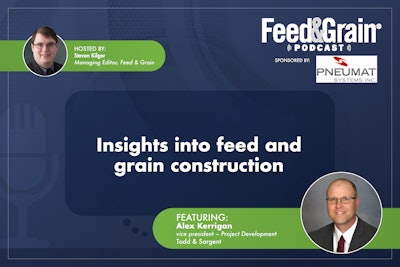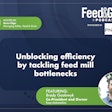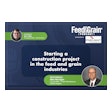
Host Steven Kilger, the managing editor of Feed & Grain Magazine and Alex Kerrigan, vice president – Project Development at Todd & Sergeant continue their discussion in the second part of a fascinating interview on starting construction projects. They explore common project delays and essential pre-project information for construction projects in the feed manufacturing and grain handling sectors.
Podcast sponsored by Pneumat Systems.
Steven Kilger (0:00):
Hi Everyone! My name is Steven Kilger, I’m the Managing Editor for Feed & Grain Magazine and the host of the Feed Grain Podcast. Thank you so much for joining me today as we dive deep into the issues affecting the Feed Manufacturing, Grain Handling and allied industries.
Kilger (0:14):
Today’s episode is brought to you by The BinWhip from Pneumat Systems. The powerful Dual Impact BinWhip removes the toughest buildup and blockages in industrial storage silos – without hazardous silo entry. Learn more today at binwhip.com.
Kilger (0:29):
Today’s episode is the second of a two-parter with Todd & Sergeant’s Vice President – Project Development, Alex Kerrigan. We’re talking about what it’s like to start a construction project in the feed manufacturing and grain handling and processing industries and in this episode, we talk about common issues that delay projects, information that should be gathered before the project starts, and what the start of a project is like.
Kilger (0:52):
I hope you enjoy the interview, if you want to help out with the podcast and are listening to this in a podcasting app please rate us and subscribe! If you’re listening online sign up for the Feed & Grain Newsletter Industry Watch to see the latest podcasts and stay up to date with all of the latest news from around the industry. Now, let's jump right in. One of the things I always thought was really interesting, and probably a reason to bring in a contractor like Todd & Sergeant early is you guys have access to other people who might have done the same thing. And then access to maybe getting people tours through those facilities and stuff like that. To kind of look at, you know what's best. And what's new out there? And what other people are building, which is really helpful. You'd be shocked at the amount of facility visits I go to and people like yep, that's the best thing we did, we toured another facility that was similar to what we wanted. So we can kind of understand what we liked about what they did, and what we might have to do for ourselves.
Alex Kerrigan (1:49):
That's a great comment, Steve, because obviously, we are building these facilities all the time. And I say all the time, it certainly takes a fair amount of time to build these facilities. But you know, we're building a feed mill or grain elevator or flour mill probably two or three a year, maybe of each industry per year. And an owner could very well be building the first facility they ever thought of you know, it might be a hog integrator that has a lot of live operations and has a processing facility but has been buying their feed from a Toll Miller, this might be a completely new venture to them.
Kerrigan (2:25):
You know, a lot of times we'll hear from someone, Hey, I just need a really fast plus or minus 25% number to determine viability. But you know, there, there's a lot more to it than that. I mean, this isn't some $80-100,000 house that you're building, this is a multi-million dollar facility. If you're going to put in this type of investment, it's worth taking the time to see some of those other facilities that other individuals already constructed or Todd & Sergeant, may have constructed. For this particular owner, it's good to see it, it's good to get ideas if you're an owner of how you might integrate some of the same best practices that that facility that you just looked at happens to have.
Kerrigan (3:04):
It's good to hear about all the different processes of the construction, that way you can create something to make up that plus or minus 25% number in terms of the division of work, Hey, is it the contractor that's tackling the Geotech? Or the civil coordination or engineering? Or is it the owner that's doing that? Does the owner have a good subcontractor or dirt worker that can handle something directly for them versus going through a construction company you talk about? Like I said before, all the things that come into play with the utilities? Hey, do you want the contractor to handle that? Or do you want to pay somebody directly to handle site utilities or railroad construction? The same thing goes with cameras, fencing, and security items like rolling stock or furnishings. If you're an owner, you might have a buddy that lives up the road from you. They can do all the finished work for an office, you don't really need to pay a contractor markup to do something that you're capable of hiring your buddy to do. Yeah, design input for a new endeavor. It's really nice to get out there and see the sights. You're right, Steve.
Kilger (4:03):
Yeah, yeah. And I mean, like you said, with a lot of people like choose to do that to you. They're like, I want to use local contractors and stuff for what I can use. That's a choice a lot of companies make to get some money into the communities they serve directly. And so here's another thing that I talked to a lot of facility people, a lot of them we have the same conversation, which is like, originally, we thought we were going to just redesign this mill. We're gonna redo our old mill, we're gonna put in a new penalty line, we were going to expand we're going to renovate. But then, we actually started doing the research and we decided it was just worth it to build a new greenfield site. What are some of the kinds of decisions or factors that go into making people decide from Hey, can we update this old facility? Or do we have to build a new one? What are some of the most common things you see on that?
Kerrigan (4:53):
Yeah, great question. Determining between renovation and new construction, those factors there. There's a lot, obviously, the cost is always going to be the major factor that the dollar spent needs to prove out on a return on investment. And I think that's pretty much what everybody thinks about what they're running their company is, hey, this is the money or that I'm gonna spend up on this massive asset, gonna have a good payback. And there are a lot of hidden items that customers should be thinking about there.
Kerrigan (5:22):
First off how are the construction activities going to impact the current operations? Whether that's in productivity or safety? Do you really want to have the headache of 20 guys walking around your plant during a shutdown? Or maybe what while you're in operation, you have those concerns of hot work, you have those concerns of, of maybe lost productivity, and like I said, that safety side, you want to make sure that everybody that's in operations is in a safe condition while you also have these construction teams on site.
Kerrigan (5:55):
And you just have to think through that. Does this retrofit plan or this shutdown work? Does it make sense? And does it outweigh the cost savings to do that renovation versus building new? You ask yourself, hey, you know, like, Am I doing myself or my company a disservice by spending money on just a band-aid retrofit solution that's going to, it'll be nice for a few years, but heck, it might be a damn good downpayment on a new facility. By doing this band-aid, am I missing out on a system a new system and better practices that are out there that are gonna get me better yields? I think on a feed mill putting in another batching skill or putting in a higher accuracy, batching scale, or the mineral scale that he might get to get better effectiveness out of that scale, or that microsystem that saves me money by not by accurately weighing the amount of microsystems or the amount of ingredients that are going in versus some lost efficiencies and maybe some overage on on high priced ingredients. Are you missing out on better maintenance and better safety of certain pieces of equipment?
Kerrigan (7:02):
If you're building a brand new facility, chances are, you're thinking about providing access that's better than what you have in the current facility, I want to provide more stair access versus ladders, and get my guys thinking more in terms of maintaining my equipment better than what I had before. Then the other part is just I know when Todd & Sergeant built a new office here 15 years ago versus the old office we're in. Is it better team morale? Like, I love being in this new facility that we work out of today, this new office. And yeah, what does a lot of your team prefer to work in a facility with state-of-the-art improvements versus in an old one? I'm a farmer. So I think I can say this, you know, I know I've got some worn-out structures. And I know I've got some worn-out equipment. And then I know I've got some really awesome precision equipment and tractors and combine. So it's, yeah, it says, Hey, what do I like working in the state of Florida, that facility is worn out structure from days of old and obviously, you've got individuals that you've got to keep happy, you've got employees, you've got to keep happy. And if somebody else has built a state-of-the-art facility, 3545 minutes down the road, they might be swayed to want to go work for that group because of their new facility.
Kilger (8:14):
Same with your customers. Right? Exactly. That's
Kerrigan (8:18):
so I'm getting that it's our customers, you know, the processors of the world, the feed milling companies of the world, the flour mill companies of the world, grain elevators, they've got some facilities that are great to work in, and then they've got some that maybe are depreciated out and like anybody these days, it's hard to get labor, and you want to retain them. One of those niceties is having a facility that's safe to work easy to maintain, and good to be around every day. So
Kilger (8:46):
yeah, well, I mean, I'm sure you and I have both been in the facilities that have done retrofits and you go from like one side where it's nice, it's clean, it's brightly lit, you can see everything you're doing. And then you look over across the room where they still have, you know, pigeons flying around, you know, old 50-year-old equipment, if you like, oh, yeah, certainly rather work in one half of this than the other. But
Kerrigan (9:10):
having said that, I mean, there is something to be said, I've maybe turned back on myself a little bit here. There is something to be said about having familiarity with the facility that you have already. This is maybe the thing that you have to consider for a newer facility. You've got to train your employees for new equipment, versus the equipment and the intricacies that you've known for years or your employees have known for years. I joke about it. Sometimes it's the Fonzie approach, you know, you hit the jukebox and it starts working well. Hell, it's kind of the same thing. I'm not gonna say that you hit a pellet mill and it just starts working but it's that thing of, hey, if I just do this, this, and this and tweak that I just know that it purrs like a kitten when I do that, you know, and everything's gonna be fine.
Kilger (9:49):
I know that clunking sound means it's about done.
Kerrigan (9:53):
There are certainly some areas in your facility that you just know how to make it work and you can keep it running in just spinning like a top as long as you perform these particular PMS. And so yeah, there's a lot to weigh when you're considering a new facility versus retrofitting or, you know, setting up a renovation for a facility.
Kilger (10:13):
Yeah, definitely. So we talked about a little bit, but what are some common challenges that companies face? What do you see often when people are thinking about this new build? What should people expect? Well,
Kerrigan (10:26):
I don't know, if competitor colleagues would agree or not, I bet they wouldn't be far from it as one of their their top concerns. What's always the biggest difficulty is getting out of the ground, you know, when you're doing below grade work, it just so much comes into play, the common challenges that you might face or need to have mitigated a result has to do with the site work conditions? Is it a muddy mess? Are you working in the muck area? Are you in the bottom of a hole? Like, literally? Do you have a bunch of hills around you? And are you building in a hole? Have you made the wise decision or I would like to say the wise decision to build high and dry you know, get get up out of that hole get get your facility located, at least at a higher spot than the absolute lowest grade, as it was surveyed out? Anyway, delays are due to permitting or utility approvals.
Kerrigan (11:18):
I mentioned that before, those are some of the most common challenges if you think you've had a phone call conversation with an authority having jurisdiction that went really well. And then you realize, well, I didn't get anything in writing from them yet. And turns out, it's going to be a three-month review by their colleagues. And it might be six months before you get the permit than I told you last week, you'd have in your hands by the end of the month. That happens a lot. The biggest thing is, everybody always says themselves Location, location, location, you think that upfront? Well, and you're in the middle of construction, all of us folks in the construction world say weather, weather weather? Is it good weather conditions? Is it freezing cold? Are there winter conditions that need to be accounted for, if you're down in the south, and it's 95 degrees or 110-degree heat index, and you're handling rebar that you feel like is about to sculpt your hands, even through your leather gloves, those are challenges that you always have to deal with.
Kerrigan (12:17):
So by setting up or sequencing your project, so that you are building in conditions that the labor force is most productive in, it'll make a world the difference in the cost of the facility construction, and obviously, how long it takes to build it. If you're building a facility in Iowa or Minnesota, and you're starting that construction, in October, you're basically working through two winners, and you're paying for that winterization costs to work through those two winners. You know, I guess I'd say those three things, Steve, are the biggest ones to me that I think of are the side that it's conditions, delays due to permitting or utility approvals. And then just Where are you working geographically? And what are the weather conditions?
Kilger (13:04):
All really good points. Because I've, I see a lot of press releases, you know, for companies deciding to build a facility and stuff. I've never seen any of those projected dates open, be quiet. They're always like, Oh, no, definitely winter, a year from now. And you're like, I don't, it doesn't happen. Well, yeah.
Kerrigan (13:24):
I mean, I will do a shameless plug, unless they're cotton sergeant. Of
Kilger (13:28):
course, of course. And that was, that is no criticism to any construction company. Because like, I just think, in in the minds, when you're planning these things out, in your mind, you're always like, everything's gonna go perfectly. Everything's gonna be smooth. And we're not going to have to delay ease with getting materials or, you know, trying to do slip form pouring in the middle of the winter in a snowstorm is about to hit like, no one thinks about that stuff right? In your head. It's just like, oh, no, we're just this is how long it should take this is how long it will take.
Kerrigan (13:55):
Yeah, but it's true in anything, the more time you can spend planning upfront, the fewer hiccups or pitfalls that you tend to run into, you know, throughout the construction process and startup process.
Kilger (14:07):
Yeah, definitely. And how can companies kind of No, no, use your expertise and talk to people and get kind of realistic budgets first and foremost, and the timelines for their projects?
Kerrigan (14:23):
Like I mentioned earlier, you know, somebody might ask for a plus or minus 25% Number. The best thing is to have as well-defined a scope as possible. So that a pre-construction manager or project developer for a construction company can walk through every single aspect of the job with you and confirm that anything that's going to be needed to plan develop or design this job is included in the scope of work that the owner is considering. That's a pretty vague answer. But as I said before, the more time you can span, putting it together, the better it is, if that's a year in advance, man, you can cover a lot of development and design considerations in one year, it's a whole hell of a lot harder to pack all that into a two or three-month timeframe. Maybe I just leave it at that.
Kilger (15:16):
Definitely, a big advantage of working with a contractor like Todd & Sergeant is, that you have experience with that stuff. Because once again, it's easy to like, try to figure it out on pen and paper by yourself, and come up with what you think is gonna be a realistic estimate. And then once you know you're in the field, it just doesn't work out that way.
Kerrigan (15:34):
The nice thing is, that most owners know what they want. Most owners before they build a facility have some great ideas. And all we really do is just take those great ideas and take those thoughts. And we just start soundboard and off of each other. We just, this is a great idea. Let's consider these particular variables that might impact it. That's really all it is a lot of the time you have a technology provider, you have an owner, you have a construction company, you have a designer, you have an engineer and some field operations, guys that talk about constructability. And at least here at Tom started, you know, we just we all just sit around the table and we start running through the scope of work and putting together a custom fit or tailor-fit solution for whatever that awesome idea was that the owner started out with?
Kilger (16:26):
Yeah, definitely. In writing in anything, right? Those are the times when things actually get done when you can just sit down with a group and bounce ideas off each other and talk things through. Well, thank you so much for coming and talking to me and our listeners today. I really appreciate it. We can have you back on soon.
Kerrigan ( 16:45):
Yeah, have a lot of fun. Most people in the industry are aware I usually run long and chat quite a bit. So hopefully I didn't bore everyone to death. Hopefully, there's some Iota knowledge you can gain out of the interview here. And yeah, I look forward to catching up with you soon. Steve.
Kilger (16:59):
Oh, you're selling yourself short. There's a reason that your feet and grains go to. We always love the information you do and we think you do a great job. Thank you everyone for listening out there. And we will see you next time. Stay safe.
.jpg?auto=format%2Ccompress&crop=faces&fit=crop&h=48&q=70&w=48)


















